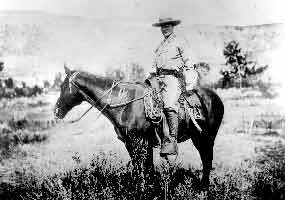
"I heartily enjoy this life, with its perfect freedom,...and there are few sensations I prefer to that of galloping over these rolling limitless prairies ,.. or winding my way among the barren, fantastic and grimly picturesque deserts of the so-called Bad Lands…" Theodore Roosevelt The backcountry of Theodore Roosevelt National Park is open to horse use. This includes travel via backcountry trails and cross country travel. Guided trail rides are no longer offered within the park. Only weed free hay/feed is allowed in the park. Weed-free hay/feed sources Ride SafeKnow where you are and where you are going.Backcountry trails are minimally marked. It is easy to confuse a wildlife trail with a designated trail. Carry a topographic map and compass. Leave your trip itinerary with someone so they can contact us if you are overdue.
Leave no Trace.Whether you are crossing a grassy plateau, a juniper forested slope, or a barren clay butte, be aware of the impact you are having and try to lessen it. Park animals are wild.Do not approach any wild animal too closely. Be especially wary of bison. Always stay clear of these animals and give them the right-of-way. Keep at least 100 yards distance between your horse and any bison you encounter. Also be aware of ticks and rattlesnakes. Weather can be unpredictable.Be prepared for rapid changes in weather. During the summer, protect yourself from the sun and the possibility of heat exhaustion or heat stroke (carry extra water). Be on the lookout for approaching thunderstorms. Slippery when wet.Trail surfaces become extreemly slippery when wet, during and after rain showers and when snow is melting. These conditions can make riding treacherous. Avoid traveling alone.In the event of an accident or sudden illness, one or two members of a group can go for help while the others remain awaiting assistance. River and Stream Crossings.Although the Little Missouri River and its tributaries are not fast flowing, they are sometimes subject to high water, especially during spring and early summer, and can be hazardous to ford. Most of the time they can be waded; however, a horseback rider should use caution because of areas with soft bottoms and deep channels or holes. Consult rangers as to good crossing sites. Helmets save lives!The park encourages the use of safety helmets for riders. |
Last updated: September 8, 2024
